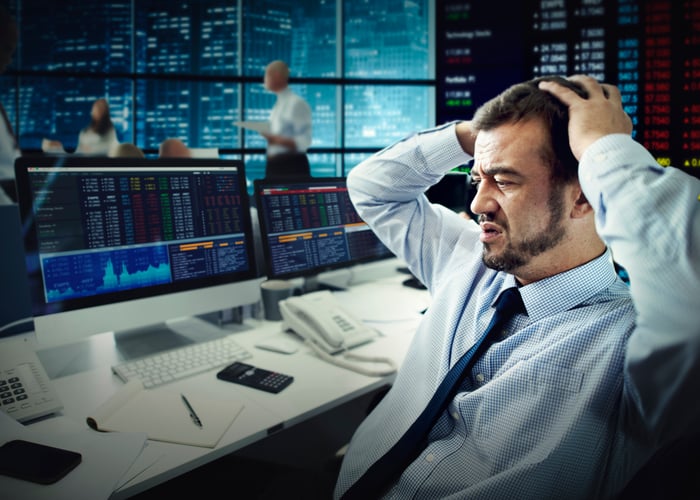Most drug companies have been relatively unstoppable over the past couple of years, partly because of the optimism surrounding a stock market that keeps hitting new all-time highs, and partly due to the incredible pricing power most drugmakers possess.
However, Valeant Pharmaceuticals (BHC 1.27%) is not like most drug companies. Since its share price peaked at $264 in Aug. 2015, Valeant has lost 93% of its market value, or well over $80 billion if we're talking about market cap.
Why Valeant has been taken to the cleaners
The embattled drugmaker has been hammered from a number of fronts. For instance, the company was heavily scrutinized over its practice of hiking prices on mature therapies that were acquired. This led to an admission of a "mistake" in the company's pricing practices from its now-former CEO, J. Michael Pearson. In recent quarters, drug pricing has been more of an impediment than a help, with regulators keeping a watchful eye on Valeant's list prices.

Image source: Getty Images.
Valeant also has massive debt woes caused by the company's strategy under Pearson's tenure to buy, buy, buy. Valeant was known for using debt to finance its acquisitions, which wasn't a bad strategy when interest rates were low and its business was thriving. However, with the company's core businesses struggling, Valeant's ballooned debt levels, which got to north of $32 billion, are more in focus than ever.
Relatively new CEO Joe Papa has made it a goal to reduce Valeant's debt load by $5 billion, if not more, by Feb. 2018. Thus far the company looks to be on track to reaching that goal. It sold three medicated skincare products to L'Oreal for $1.3 billion earlier this year ($1.1 billion of which was used to pay down debt), and at the same time announced that it had divested its Dendreon business, which includes cancer immunotherapy Provenge for metastatic castration-resistant prostate cancer, to China's Sanpower for $819.9 million. More recently, it announced the sale of Australia's iNova Pharmaceuticals for $930 million.
Through its first-quarter report, Valeant announced debt reductions of $3.6 billion since the first quarter of 2016, and this didn't count the completion of the Dendreon sale or the iNova sale. Combined, these two sales should get Valeant to its $5 billion debt-reduction mark.
Another asset sale, another deep disappointment
But the company is nowhere near done with its fire sale. On Monday, Valeant announced that it had reached an agreement to sell Obagi Medical Products, a producer of topical aesthetic products, for $190 million to Shonghua Finance Acquisition Fund. While Wall Street cheered, this Fool (again) jeered, because the sale price for Obagi Medical Products is 56% below what Valeant paid for the company four years ago.

Image source: Getty Images.
According to Wells Fargo analyst David Maris, the sale of Obagi only represents a premium of 2.2 times revenue and about 6.3 times EBITDA. This compares to comments from Valeant's management team when they announced their intention to sell assets last year that they'd be seeking about 11 times EBITDA as an average for their non-core assets. The Obagi sale wasn't even in the ballpark.
What's more, Maris' estimate suggests that Obagi was on track for about $85 million in sales in 2017. The year before Valeant acquired Obagi, it produced about $120 million in sales. This nearly 30% reduction in sales over five years sums up what's happened to most companies that have come under Valeant's ownership in recent years.
Here's the real issue
The problem with Valeant's approach to debt reduction is that while the nominal total debt levels are falling, the company's debt covenants continue to worsen.
Valeant's lenders often look to the company's full-year EBITDA as a measure of their loans' safety. In particular, the ratio they're concerned with relates to how much EBITDA Valeant generates in a year compared to how much it spends servicing its debt via interest and fees. In the first quarter, Valeant generated what might seem to be a healthy $861 million in EBITDA, but it spent $471 million servicing its debt. This EBITDA-to-interest coverage ratio hit a new low of 1.83-to-1, which is very concerning to lenders. If Valeant were to breach its debt covenant, which currently sits at 1.5-to-1, it could require a quick repayment of its remaining debts, even if the company hasn't missed an interest payment.

Image source: Getty Images.
The issue is that every time Valeant restructures its debt and/or pushes its maturities further out, it accept fees and higher interest rates from its lenders in the process. Thus, even with $3.6 billion less in debt than the prior-year period, Valeant is paying more to service that debt as a whole.
Making matters even worse, the company's business model has badly deteriorated. Bausch & Lomb has been a decent bright spot, with constant currency sales growth of 4% in the first quarter, but its Branded Rx sales division saw sales plunge 9% in Q1 2017. Mind you, this is an operating segment that was expected to grow by 2% to 5% in 2017, but doesn't look to have a shot at those lofty figures at the moment. Without organic EBITDA growth, Valeant doesn't have a chance of raising its EBIDTA-to-interest coverage ratio, even if it manages to divest more assets. All the company is doing is buying itself more time before investors realize how much trouble it's really in.
This Fool personally sees nothing to indicate that things are getting any better with Valeant, and would use the latest sale announcement of Obagi Medical Products at well below its original purchase price as all the confirmation needed that Valeant deserves its 93% valuation haircut, if not more.





